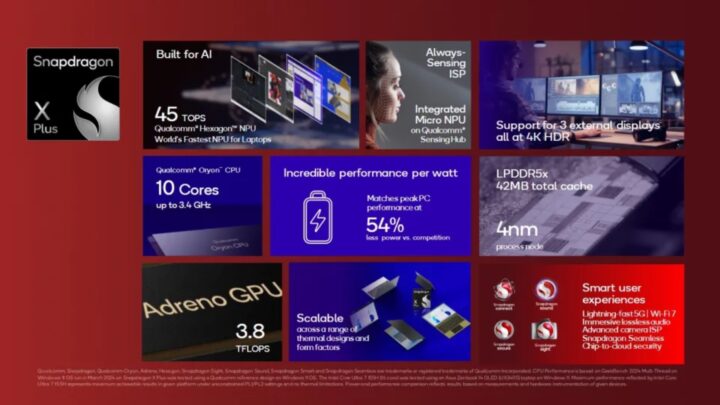[ad_1]
Qualcomm has unveiled the Snapdragon X Plus, a new ARM-based processor designed for laptops. It sits one step below the company’s flagship laptop chip, the Snapdragon X Elite, which was unveiled a few months ago and is expected to be used in Samsung’s upcoming Galaxy Book 4 Edge.
Snapdragon X Plus will be used in more affordable Windows laptops
The Snapdragon X Plus is a 4nm chip with a 10-core CPU and uses the same Oryon CPU cores used in the Snapdragon X Elite. It will be used in more affordable laptops running Windows OS. Its CPU is clocked at 3.4GHz instead of 3.8GHz on the Snapdragon X Elite. It could be equivalent to the Intel Core Ultra 7 series. According to Qualcomm’s product specifications, the Snapdragon X Plus’ integrated Adreno GPU has 3.8 TFLOPS of power.
One thing that hasn’t been downgraded in the Snapdragon X Plus is its NPU, which still offers 45 TOPS of performance for on-device AI inferencing, similar to the Snapdragon X Elite. This qualifies the chip as an AI chip as per Microsoft Copilot’s minimum requirement of 40 TOPS.
Coming to the chip’s power efficiency, Qualcomm claims the Snapdragon X Plus offers 10% faster CPU performance than Apple’s M3 chip when running at the same power. Compared to the Intel Core Ultra 7 155H, the Snapdragon chip is claimed to be 37% faster at the same wattage. This chip is expected to appear in laptops launched in the second half of this year.
Galaxy Book 4 series laptop may use Snapdragon X Plus chip
In the past, Samsung has used Qualcomm’s top-of-the-line and mid-range Snapdragon chips in its ARM laptops. Since it has already been revealed that the Galaxy Book 4 Edge will use the Snapdragon X Elite, it is possible that Samsung could launch a more affordable Galaxy Book 4 series laptop with the Snapdragon X Plus.
[ad_2]
Source Article Link


